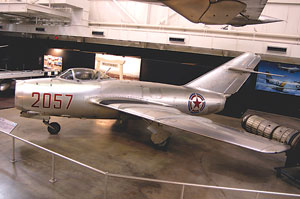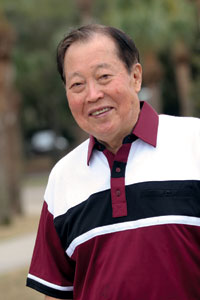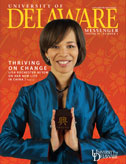
In September of 1953, less than two months after the Korean War ended with an armistice, a 21-year-old North Korean fighter pilot defected to a South Korean airfield with a state-of-the-art Russian fighter plane. A few short months later, that same pilot was living in a single in Brown Hall on The Green at UD, working toward an engineering degree. By then, Flight Lt. No Kum-Sok was known as Kenneth Rowe and was on the cusp of a successful career in aeronautical engineering, a career that started at the University of Delaware.
Trapped in North Korea
In North Korea in the late 1940s, citizens didn’t have to choose a career; it was chosen for them. No passed an entrance exam and was accepted by the North Korean Naval Academy. ”I was already an anti-communist,” he said during a recent interview. “But there was no way to get out. It was very harsh—intolerable.”
He soon found himself in flight school, eventually learning to fly what was at the time the most advanced jet fighter aircraft in the world, the MiG-15.
In Manchuria, away from prying Western eyes, he and others were trained by Soviet advisers how to fly the swept-wing fighter. “It was a crash program,” he says. “I worked very hard and was part of the first group trained by the Russians.”
Soon after the North Korean forces invaded South Korea in the summer of 1950, No found himself in combat training. By 1951, he was fighting in the skies above the battleground. “We were not really ready to fly the plane,” he says.
By then, No’s mother had fled to South Korea, but he didn’t know that. All he knew was that he was alone in one of the most dangerous professions in the world – combat fighter pilot.
“I flew more than 100 combat missions” during the course of the war, he says. Unlike in the Western air forces, in which a pilot flew a set number of missions before rotating out of the combat zone, North Korean pilots flew for the duration of the war.
“You flew until you died,” No says. “I almost lost my life many times.”
Flight to the West
A scant 56 days after the armistice halting the war was signed in 1953, No found himself scheduled to fly out of a North Korean air base at Sunan, on the outskirts of the North Korean captial. He had decided he was going to do what no pilot had yet done. He was going to defect to the West, and take his top-secret MiG-15 with him.
“I figured I had a 20 percent chance of success,” he recalls. “I thought that was good enough.”
U.S. Air Force personnel were on the flight line when a jet appeared on the downwind leg of Kimpo Air Force Base landing pattern, but they paid little attention to the plane, figuring it to be an Air Force F-86 Sabre, a plane that shares some similarities with the MiG-15.
No landed and rolled to a stop before astounded servicemen realized what the plane was. He was surrounded by American pilots, and the plane was whisked away into a hangar. In fact, it was months before the world learned that the U.S. had just gained a priceless MiG.
No was given the $100,000 reward the U.S. government had offered for a MiG. He says that he didn’t know about the reward while in North Korea. He just wanted to get free.
To No, the MiG was a way to get to the West. For the U.S., it was an invaluable example of a key communist weapon, one primed to be studied and flight-tested.
In fact, while No was being introduced to the U.S. (where he chose the name Kenneth Rowe), test pilots, including then-Maj. Chuck Yeager, were putting the plane through its paces. Yeager and another pilot, Capt. H.E. “Tom” Collins, reported that the plane had some dangerous flight characteristics and some design flaws.
For a time, Rowe assisted test pilots on Okinawa and told them about his experiences with the North Korean and Soviet air forces. The American test pilots, he says, “were the best in the world.”
Becoming an American
The first few months of Rowe’s life in the U.S. were spent as a paid contractor to American intelligence services. During this time, he frequently traveled by rail between Washington, D.C., and New York. When it came time to choose his next step, he knew where he wanted to go.
“I had seen Newark [Delaware] from the train and knew it was a good engineering school,” he says. “I still wanted to be an engineer.”
Even with all the experiences he had been through, Rowe found himself somewhat unprepared for life on his own. “I didn’t even know how to cash a check,” he says.
But he soon learned. He enrolled in UD’s College of Engineering, moved into a single room on the fourth floor of Brown Hall and, between classes, regularly visited Main Street as students do today. His University education “was an important steppingstone in my life, a very important part of my life,” he says.
After earning a bachelor’s degree in mechanical engineering, he earned another in electrical engineering and became an aeronautical engineer.
Rowe was reunited with his mother, who came to the U.S. to live with him. One of his first jobs was with the DuPont Co. Experimental Station near Wilmington.
After that came jobs as an aeronautical engineer with Boeing, Westinghouse, General Electric and a number of other companies. Along the way he married and built a family. But, Rowe says, among all his accomplishments, there is one he is particularly proud of.
UD history Prof. John A. Munroe convinced then-Sen. J. Allen Frear of Delaware to introduce a special bill to declare Rowe a U.S. citizen. It was signed by President Eisenhower.
“And it was all because of John Munroe,” Rowe says of the well-known and respected Delaware historian, who died in 2006. “He and I, we were very close.”
Life today in retirement

When Rowe came to the University of Delaware 56 years ago, he had been trained to do one thing—fly.
Since then, he credits his undergraduate years with setting him on the course for a very successful life. He returned to Newark once, for a reunion, and although he hasn’t been back since, he says he often thinks about his student days.
In 2000, he retired from Embry-Riddle Aeronautical University and still lives near the campus in Daytona Beach, Fla.
Another survivor from that era is a silver, swept-wing MiG-15. It sits, beautifully restored, in a building at the National Museum of the U.S. Air Force at Wright-Patterson Air Force Base near Dayton, Ohio.
The plane looks as it did back when the man who would become Kenneth Rowe turned onto final approach at Kimpo in 1953, becoming the “Yankee” he had been trained to shoot down.
EDITOR’S NOTE: Kenneth Rowe recounted his own story in the book A MiG-15 to Freedom, written under his original name, No Kum-Sok, with co-author J. Roger Osterholm. Rowe has also written a memoir, “The Last Day of the Korean War,” published in the Friends Journal of the Air Force Museum Foundation.
Article by Ted Caddell, AS ’83





